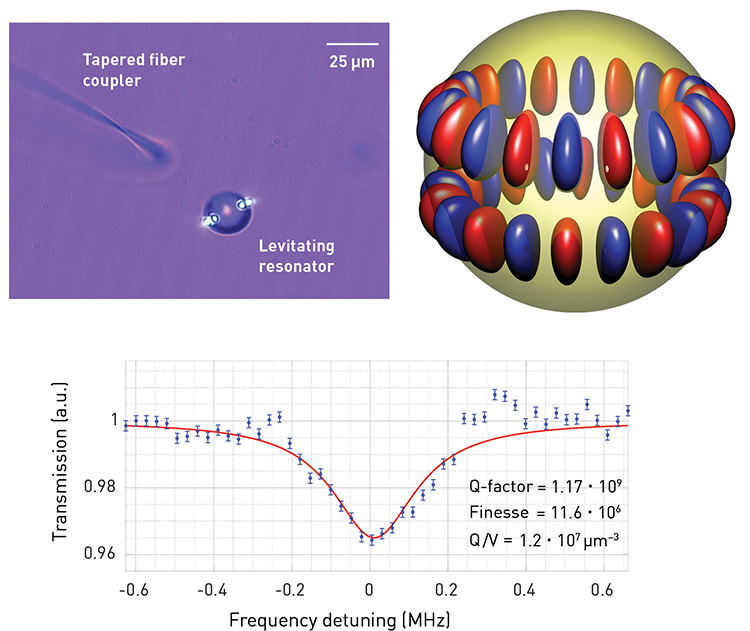 Top left: A micrograph of the experimental setup for the levitating photonics experiment featuring an optically tweezed resonator. Top right: The calculated structure of a typical optical mode in the spherical resonator. Bottom: Experimental results show the transmission spectrum through the levitating cavity as measured via the fiber using a photodiode. Blue represents experimental measurements and red is a fit to a Lorentzian model.
Top left: A micrograph of the experimental setup for the levitating photonics experiment featuring an optically tweezed resonator. Top right: The calculated structure of a typical optical mode in the spherical resonator. Bottom: Experimental results show the transmission spectrum through the levitating cavity as measured via the fiber using a photodiode. Blue represents experimental measurements and red is a fit to a Lorentzian model.
In recent work, assisted by optical tweezers, we experimentally demonstrated a levitating microresonator near a tapered-fiber coupler. Our levitating cavity permits dimensionless quality factor/mode volume (Q/V) values of 4.1 million—representing, to the best of our knowledge, the highest such resonance enhancement yet reported.
In our experiment, we used a levitating ultra-transparent oil droplet actuated as a whispering-gallery-mode resonator by attaching it to a tapered-fiber coupler.1 Optical tweezers then enabled the levitation of the droplet. The resonances, which arise whenever the integer number of the wavelengths fits into the resonator’s circumference, were observed as Lorentzian dips in the spectra of light transmitted along the fiber and measured using a photodetector. We determined the Q-factor of the resonances from the linewidth to be Q ≈ 1.2 x 109 and computed the mode volume, using the Mie theory, to be equal to 290 (l/n)3. Consequently, the dimensionless Q/V factor was found to be 4.1 million.
We believe the performance of our levitating resonators benefits from the fact that optical tweezers, in contrast with regular tweezers, do not contaminate our resonator. An additional feature of our approach is the almost ideally spherical shape of the resonator with deviations from sphericity less than an Angstrom, implying a highly degenerate nature for the resonance modes.
Resonators are very important devices in optics, and their permitted resonantly enhanced-intensity (per unit input-power) scales with Q/V.2,3 Our contactless photonics boosts Q/V by reducing optical losses and mode volume. Our levitating photonics is compatible with standard fiber technology and is scalable to many devices, enabling a levitating optical circuit.
Researchers
Jacob Kher-Alden, Shai Maayani and Mark Douvidzon, Technion – Israel Institute of Technology, Haifa, Israel
Leopoldo L. Martin, Universidad de La Laguna, Spain
Lev Deych, Queens College, City University of New York, NY, USA
Tal Carmon, Tel Aviv University, Israel
References
1. J. Kher-Alden et al. Phys. Rev. X 10, 031049 (2020).
2. K.J. Vahala. Nature 424, 839 (2003).
3. M.L. Gorodetsky et al. Opt. Lett. 21, 453 (1996).

